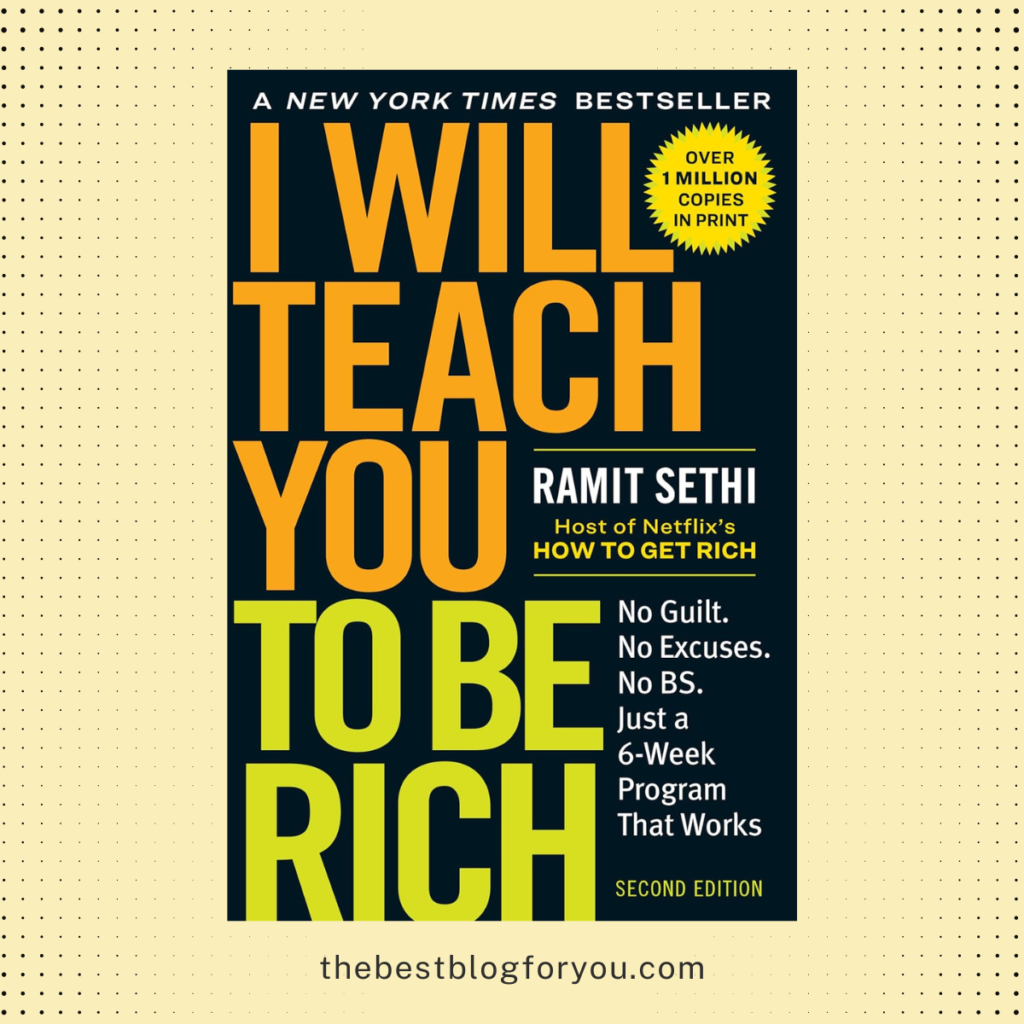
Intro
In today’s fast-paced world, mastering your finances can feel overwhelming. Ramit Sethi’s book, **I Will Teach You to Be Rich**, offers a comprehensive guide to achieving financial freedom with practical advice tailored for young adults. The book emphasizes building a strong financial foundation, optimizing bank accounts, and cultivating an abundance mindset. This post will delve into the key takeaways from Sethi’s work, providing you with a roadmap to financial empowerment.
Building a Strong Financial Foundation

In **I Will Teach You to Be Rich**, Sethi emphasizes the significance of laying a strong financial foundation as a precursor to achieving lasting wealth. This begins with setting up automatic systems to manage your money effortlessly, directing funds into savings and investments without the need for constant oversight. Sethi suggests the establishment of a no-fee checking account for daily transactions and a high-yield savings account dedicated to emergency funds, ensuring your money works for you even in times of financial stress.
Moreover, Sethi advocates for early investment in retirement accounts, such as 401(k)s or IRAs, to take advantage of compound interest and long-term market growth. The idea is to start these practices as early as possible to maximize potential returns. By automating contributions to these accounts, you can ensure consistent saving and investing, which is crucial for building a robust financial safety net.
Another vital aspect is keeping a close eye on fees and interest rates. Sethi advises opting for financial institutions that offer no-fee accounts and competitive interest rates, which can significantly impact your savings over time. By minimizing unnecessary fees and optimizing where your money is held, you can improve the efficiency of your financial setup.
By prioritizing these foundational steps, you lay the groundwork for a financially secure future, setting the stage for more advanced strategies in saving, investing, and wealth-building as discussed throughout the book.
Optimizing Your Bank Accounts for Better Efficiency

Choosing the right bank accounts can significantly impact your financial efficiency. Ramit Sethi underscores the importance of finding banks that provide no monthly fees and high-interest rates. Online banks often offer better returns on savings compared to traditional banks, making them an attractive option for savvy savers. In **I Will Teach You to Be Rich**, Sethi recommends setting up multiple accounts tailored to specific financial goals, such as a travel fund, emergency savings, or a down payment for a house. This segmentation not only helps in tracking your progress but also ensures that your money is earmarked for its intended purposes.
Sethi also advises paying attention to the fine print. Hidden fees and unfavorable terms can erode your savings over time. It’s essential to choose accounts that align with your financial needs and offer transparency. Furthermore, automating your finances, such as setting up automatic transfers between your checking and savings accounts, can streamline your money management and help you stay disciplined in your saving habits.
Regularly reviewing your bank accounts to ensure they still meet your needs is also crucial. As your financial situation evolves, the features and benefits that were once appealing might no longer serve your best interests. By staying proactive and making necessary adjustments, you can maintain an efficient banking setup that supports your financial goals.
Effective Strategies for Paying Off Debt Quickly

Debt can be a significant barrier to achieving financial freedom. Ramit Sethi offers practical strategies for tackling debt effectively. He recommends the “snowball method,” where you focus on paying off the smallest debts first while making minimum payments on larger debts. This approach builds momentum and keeps you motivated. Additionally, Sethi advises negotiating lower interest rates with creditors to reduce the overall cost of your debt.
Assessing your spending habits to identify areas where you can cut back is another key strategy. Redirecting these savings towards your debt payments can accelerate the repayment process. Sethi also emphasizes the importance of avoiding new debt while you’re in repayment mode. By being disciplined with your finances and prioritizing debt elimination, you can free up more money to save and invest in the future.
Maximizing Credit Cards Without Falling Into Debt

Credit cards, when managed wisely, can be powerful tools for financial growth. Ramit Sethi, in **I Will Teach You to Be Rich**, illustrates how to harness the benefits of credit cards without falling into debt. One of his key recommendations is to always pay off your balance in full each month. This habit not only helps you avoid costly interest charges but also keeps your credit score in good standing, which can be advantageous for future financial endeavors.
Sethi highlights the perks of using credit cards for their rewards programs. Many cards offer benefits such as cash back, travel points, or other incentives that can add significant value. The trick is to use these cards for regular expenses you can afford to pay off immediately, maximizing rewards without incurring debt.
Understanding the terms and conditions of your credit card agreements is crucial. Sethi advises being vigilant about interest rates, fees, and other fine print details that could undermine your financial strategy if overlooked. He also suggests regularly reviewing your credit card statements to spot any discrepancies or unauthorized charges promptly.
Another valuable strategy Sethi discusses is leveraging the customer service aspect of credit card companies. Don’t hesitate to negotiate for lower interest rates or to request the waiving of fees. Many people are unaware that such negotiations are possible, but with a well-prepared approach, you can often secure better terms.
Lastly, Sethi encourages setting up automatic payments to ensure that you never miss a due date. This simple action can prevent late fees and further bolster your credit score, ultimately enabling you to benefit fully from your credit cards without the risk of debt.
Smart Investment Principles for Long-Term Growth

Investing wisely is key to long-term financial growth, and Ramit Sethi outlines several principles in **I Will Teach You to Be Rich**. One of his main strategies is to start investing as early as possible to take full advantage of compound interest. Sethi recommends focusing on low-cost index funds over individual stocks due to their consistent performance and lower risk. By spreading investments across various sectors, index funds offer diversification, which helps mitigate risk.
Sethi also stresses the importance of automatic contributions to investment accounts. Automating this process ensures you consistently invest without having to think about it, promoting discipline and long-term growth. He advises setting clear investment goals and aligning your investment strategy with those objectives, such as retirement or a down payment on a house.
Understanding the difference between different types of investment accounts, such as Roth IRAs, traditional IRAs, and 401(k)s, is crucial. Each has unique tax benefits and rules, and Sethi explains how to maximize these advantages based on your financial situation.
Another key point Sethi makes is the importance of keeping investment costs low. High fees can erode your returns over time, so choosing investments with low expense ratios is essential. By minimizing costs and maintaining a diversified portfolio, you can optimize your investment strategy for long-term success.
Managing Money in Relationships and Marriage

Money issues can strain relationships, but Sethi offers strategies to navigate these challenges in **I Will Teach You to Be Rich**. He suggests having open discussions about finances with your partner and establishing shared financial goals. This involves setting aside time to review each other’s financial situations, including income, debts, and spending habits. Transparency is key to ensuring that both partners are on the same page.
Sethi advocates for the use of separate and joint accounts to balance personal freedom with shared responsibilities. Joint accounts can be used for household expenses and savings goals, while individual accounts allow for personal spending without the need for constant approval. This setup helps in managing day-to-day expenses and long-term financial planning effectively.
Another critical aspect Sethi highlights is the importance of aligning on major financial decisions, such as buying a house or planning for retirement. He advises couples to agree on big-picture goals and create a plan that reflects their collective priorities. This collaborative approach can prevent misunderstandings and conflicts down the road.
Regular check-ins are also essential. Scheduling periodic financial reviews can help couples stay aligned with their goals and adjust their plans as needed. By fostering a habit of ongoing communication and mutual respect regarding money matters, couples can build a stronger financial partnership. This proactive approach helps in managing both present and future financial challenges, ensuring a more harmonious relationship.
The Psychology of Spending and Conscious Spending Plans

Understanding your spending habits is vital for financial success. In **I Will Teach You to Be Rich**, Sethi introduces the concept of “conscious spending.” He encourages readers to identify their priorities and allocate money toward things they love while cutting back on areas that don’t bring joy. This approach enables individuals to enjoy their money guilt-free and make informed spending decisions. Sethi’s mantra is to “spend extravagantly on the things you love, and cut costs mercilessly on the things you don’t.”
Sethi emphasizes the need to break away from the traditional budgeting mindset, which often feels restrictive and punitive. Instead, he proposes creating a Conscious Spending Plan that reflects your values and aspirations. This plan involves dividing your income into four major categories: Fixed Costs (like rent and utilities), Investments, Savings Goals, and Guilt-Free Spending (on things that make you happy). By allocating a portion of your income to guilt-free spending, you can indulge in your passions without feeling financially irresponsible.
This approach requires a deep understanding of what truly matters to you and the discipline to cut back on non-essential expenses. By focusing on intentional spending, you can enjoy a more satisfying and balanced financial life. Regularly reviewing and adjusting your Conscious Spending Plan ensures it evolves with your changing priorities and financial circumstances.
Negotiation Techniques to Increase Your Income

Negotiating your salary and benefits can have a significant impact on your financial future, and Ramit Sethi offers actionable advice to do it effectively in **I Will Teach You to Be Rich**. Start by thoroughly researching industry standards for your role and experience level. Use resources like Glassdoor, LinkedIn, and industry reports to gather data on what others in similar positions are earning. Preparation is key, so practice your negotiation pitch, highlighting your accomplishments and the unique value you bring to the organization. Sethi suggests framing your discussion around mutual benefits; for instance, how your increased compensation will drive better results for the company.
Additionally, consider negotiating other aspects of your compensation package, such as bonuses, stock options, or additional vacation days, if salary increases are not feasible. Being flexible and open to various forms of compensation can often lead to more favorable outcomes. Sethi also emphasizes the importance of timing. Aim to negotiate during performance reviews or after successfully completing a major project.
By approaching salary negotiations with confidence and a well-prepared strategy, you can secure a better financial position and enhance your overall career trajectory.
Crafting a Rich Life Beyond Just Financial Wealth

Financial wealth is just one component of a truly rich life. Ramit Sethi encourages readers to envision what a fulfilling life looks like beyond their bank accounts. This involves identifying personal values and passions, such as spending quality time with family, traveling, pursuing hobbies, or contributing to causes you care about. Sethi emphasizes that money should be a tool to support these aspirations, not the sole objective.
To craft this holistic vision, Sethi advises reflecting on what genuinely brings joy and satisfaction. Allocate resources—both time and money—towards these areas to create a balanced, enriched life. For example, if travel is a priority, budget for trips and experiences that broaden your horizons. If relationships are key, invest in creating memorable moments with loved ones.
Moreover, Sethi highlights the importance of personal growth. This could mean furthering your education, developing new skills, or simply engaging in activities that challenge and inspire you. By focusing on a well-rounded approach to wealth, you can build a life that is rich in experiences, relationships, and personal achievements, ensuring that your financial success translates into a meaningful and rewarding life.

2 thoughts on “Key Takeaways from I Will Teach You to Be Rich”
Comments are closed.